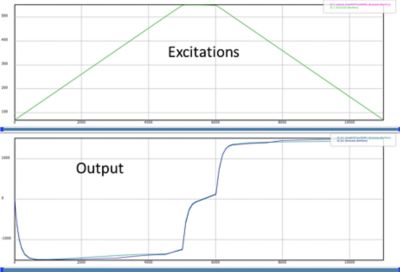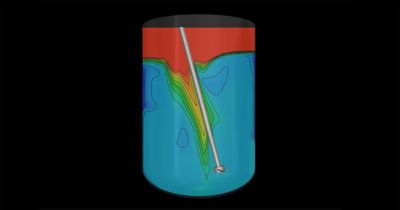Models today encompass a wide variety of use cases, from documents, spreadsheets, and scripts to simulations and system architectures. These models need to be leveraged together to represent a connected overall system to help us answer questions throughout a product’s life cycle, from inception to end of life.
What is model-based systems engineering (MBSE)? Why are people increasingly interested in using MBSE to develop their products? And how do we realize and effectively enable MBSE? The Ansys Twin Builder digital twin simulation platform can help answer in enabling and accelerating MBSE, thanks to reduced-order modeling (ROM) techniques.
MBSE is a methodology that uses models instead of documents to design a system. Most models today can be represented in digital tools, but the problem lies in connecting separate models under one umbrella to effectively use them together. If teams can integrate multiple models, engineers would be able to ask questions about a system and receive answers: Are we meeting our budget? Will our project work in this environment? Will this bolt fail? Because it is a single representation of a system, it considers other models that may not normally be included and gives a more holistic answer based on the scope of the question.
Digital models are used in all disciplines that make up a system. Engineers connect these models so they can evolve as the system does, assuring that the system meets requirements and instilling confidence in the model. To enable MBSE, teams can investigate the digital tools that subject matter domain experts use in their day-to-day operations.

Models that are supported by Ansys ModelCenter model-based systems engineering software include analyses, simulations, scripts, spreadsheets, and singular or multiple toolchains (right). The Ansys System Architecture Modeler (SAM) capability is pictured on the left.
System architecture models are created by systems engineers and describe the system being designed, including its structure, behavior, and requirements. System architecture models describe the system being designed, but they are not executable. To ensure that the system meets requirements, the system architecture model must be connected to engineering analysis. This connection is the role of Ansys ModelCenter model-based systems engineering software, which forms a bridge between the system architecture and engineering analysis models.
This connection is essential to the MBSE process. It not only enables requirements verification but can be used to perform trade studies, such as design of experiments, optimizations, and parameter studies. With ModelCenter software, you can find a solution that both works and exceeds expectations.
Integrating Model-based Systems Engineering for Simulation
As an example, Ansys created a successful model with a customer. The goals outlined for the project were to integrate a systems architectural model with existing physics models, including Ansys physics solvers, to verify that the designed system met performance requirements.
With these goals in mind, Ansys leveraged a multitude of different engineering analysis tools, including solvers ranging from electronics to thermal and mechanical solvers. The project team integrated these in ModelCenter software to create a connected workflow. The Ansys System Architecture Modeler (SAM) capability in ModelCenter software then created a model of the system that described the structure, behavior, and requirements. The ModelCenter workflow, including ROMs from Twin Builder software, was connected to the SAM to verify that the requirements were met by the design.

Requirements verification in the ModelCenter SAM tool
This solution benefited from ModelCenter software and the Twin Builder platform’s vendor-neutral approach to integration, which enables users to verify system requirements with any engineering analysis tool, not just those included in Ansys’ product portfolio.
A final benefit to mention pertains to Twin Builder software. In some cases, if your system requirements change or are not met for some reason, then you want to be able to quickly find a design alternative. The iterative process of finding a design alternative can be very time-consuming if you must repeatedly run the full physics solver. To combat this, fast-running ROMs created by Twin Builder software can help achieve time savings of 50 to 100 times.
System Architecture Models, 3D Solvers, and the Twin Builder Platform
Let’s start with the system architecture model. This was created with the ModelCenter SAM tool, but other vendor tools could be used for the same purpose.
A system architecture model is typically created by systems engineers within their chosen tool and consists of a detailed architecture model of the system being designed, including structure, behavior, and system requirements. If you talk with systems engineers, this model is often called an “authoritative source of truth” for the system architecture. For creating discipline-specific engineering models for electrical, thermal, and mechanical engineering problems, the simulations and models that were leveraged came from Ansys IcePack electronics cooling simulation software for electronics, Ansys Fluent fluid simulation software for thermal, and Ansys Mechanical finite element analysis (FEA) simulation software for structural. Other scripts were also used to postprocess the data from these tools. Ansys automated and integrated these models with ModelCenter software to create a workflow known as the ModelCenter failure simulation workflow.
Up to this point in our project, Ansys simulation solvers have been used to build the workflow. The time it takes to run each component in the workflows can be upward of four hours, depending on the setup. This would be problematic if parametric studies or optimizations were run to improve the design. To fully explore the design space would require 1,600 hours of solve time, which isn’t feasible for accommodating project deadlines.

ModelCenter failure simulation workflow reduced-order models (ROMs)
To solve this time problem, Ansys enhanced the multidisciplinary ModelCenter workflow so it would run more quickly. Twin Builder software was used to create ROMs of our long-running simulation components. Within this workflow, we added a Fluent ROM, as well as a Mechanical ROM with an IF statement to help toggle between the full simulation or the accompanying ROM. With these changes, time savings of at least 100 times were achieved. Our solve time went from 1,600 hours to 16, which is much more manageable.
Integrating Dynamic ROMs Into the ModelCenter Workflow
To obtain accurate results, this application requires the creation of ROMs that can take transient inputs and predict the dynamic evolution of the response. This is achieved through dynamic ROMs. Dynamic ROMs are tailored for transient nonlinear problems that can have both scalar and field outputs. In this case, the output is a scalar quantity. To create a dynamic ROM, the inputs and outputs must change in time. The ROM builder identifies a relationship between inputs and outputs and creates a ROM.
The use of dynamic ROMs resulted in huge time savings. In this case, the FEA simulation took 12 hours to complete, and the dynamic ROM evaluation took approximately two seconds to simulate the same event. In addition to being much faster, ROM predictions were very accurate and were within 5% of the FEA simulations. Therefore, both ROMs and dynamic ROMs are valuable tools used to conduct parametric and trade studies.

Excitations and comparison between the high-fidelity model and ROM for the selected scenario
There are at least two ways to consume dynamic ROMs in ModelCenter software. The first approach is using the ModelCenter FMI plugin. First, the models need to be converted to functional mock-ups (FMUs). Currently, this approach only works for FMUs and models that are static and do not have an internal clock. This works well for response surface and a static ROM. However, dynamic ROMs and FMUs that require time are not supported in this approach. The second approach is to integrate them using PyAEDT in ModelCenter software. For this, a Python script is executed in ModelCenter software. This script calls for a Twin Builder model that contains the dynamic ROM. The ROM is then executed, and the results are passed on to ModelCenter software.
The first step of this integration is to prepare the ModelCenter and Twin Builder projects. The second step is to create a PyAEDT script. This script calls the data, reads it into Twin Builder software, simulates the ROM, and generates the simulation results. The simulation results are passed to ModelCenter software, where they can be combined with results from other pieces of the workflow to conduct trade studies.
Requirements and Trade Studies
For this project, because ModelCenter software is connecting the SAM tool to the ModelCenter workflows, you can make sure the requirements are being verified by whichever analysis toolchain it is executing. In this example, the initial requirements verification run was made by the systems engineer. ModelCenter software can be launched directly in the system architecture tool to perform the requirements verification run. In this case, not all the requirements were satisfied.
Another enabling feature of ModelCenter software is leveraging built-in trade study tools to find alternative designs. Using ModelCenter software’s MBSE capabilities with the toolchain workflow model, we can start to exercise it using the trade study tools. After running parametric studies and trade studies using the workflow that included Twin Builder ROMs, the design alternatives were narrowed to a small sample. With this sample of designs, Ansys then performed further analysis, mainly optimizations and probabilistic analysis to help explore the models’ robustness. The project team was able to use the original 3D physics models compared with the ROMs to verify all the alternatives against the requirements. So, starting with an imperfect design, setting up a design of experiments to explore the overall design area, and narrowing the selection of alternatives enabled finding a better-performing optimized design that now meets all system requirements.
Speeding Up Analysis With Ansys Solutions
To summarize, Ansys created several different types of models using many different tools: a system architecture model, 3D physics models, and ROMs. ModelCenter software was then used to automate and connect these models and tools. Through the Twin Builder platform, fast-running ROMs were created for some of Ansys’ physics solvers to accelerate solve times and be used in trade studies. Using these connected models, the project team could quickly and easily verify system requirements, compute performance metrics, and identify design alternatives.
To request a free trial, visit the Twin Builder platform webpage. For more information on ModelCenter software and other MBSE solutions, click here. Last but not least, learn more about the SAM tool.















